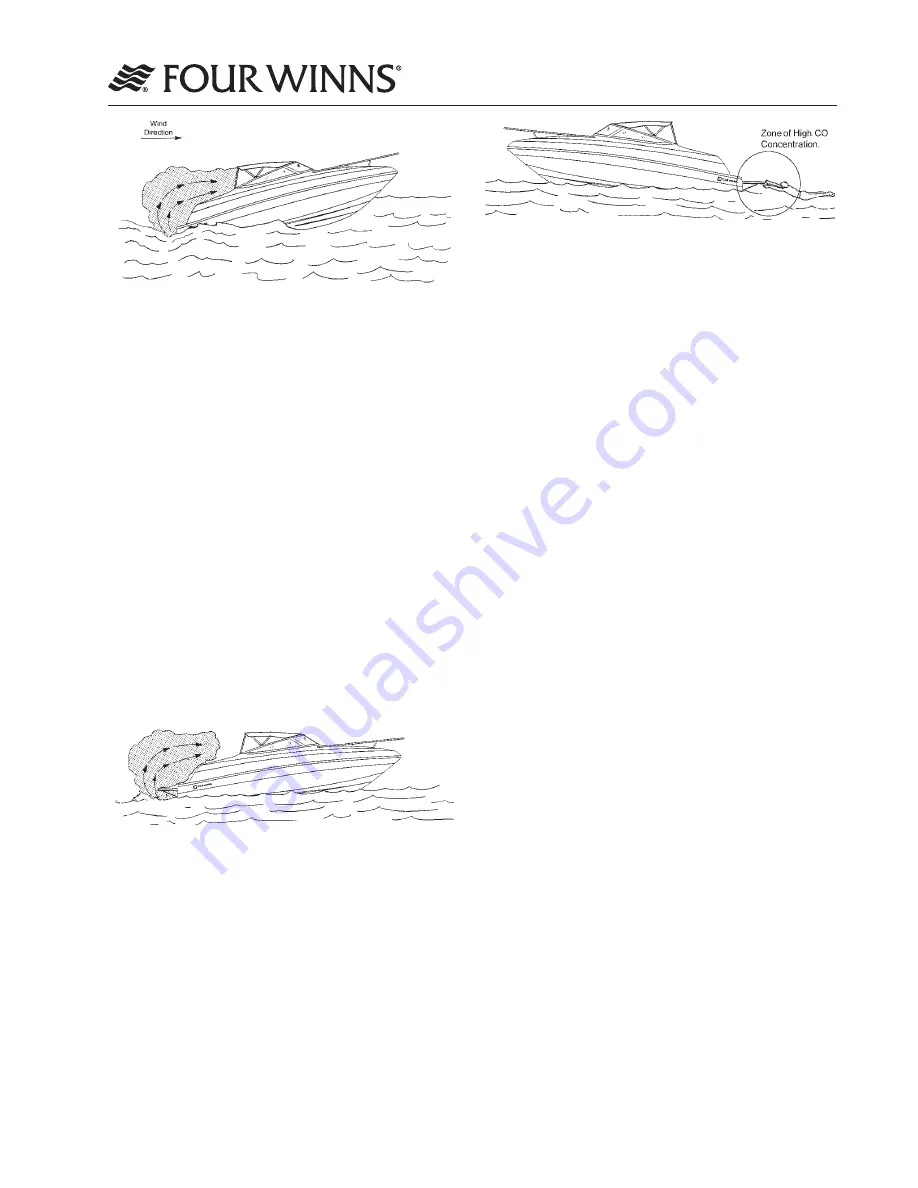
Owner’s Manual Page 33
Boating Safety - Section B
Figure B13: Operating at Slow Speed
with Following Wind
6. Be aware that cockpit and deck drains can be a
source of CO ingress into boats, especially boats
with cockpit or decks enclosed with canvas or
permanent boat structures.
L. Accumulation of Exhaust Gases-
Swim Platform
When the propulsion engine(s) or generator is
running, CO is produced and may remain in the
vicinity of the exhaust outlet (including underwater
exhaust outlets such as sterndrives and outboards).
Refer to Figure B14.
1. Do not occupy aft lounging area(s) or swim
platform.
2. Do not swim under or around swim platform.
3. Do not swim in the vicinity of the exhaust outlet.
Figure B14: Exhaust Gas Accumulation
at Swim Platform
M. Dangerous Activity -
“Teak Surfing”/“Dragging”
Do not sit on, occupy or hang on any stern append-
ages (e.g., swim platforms, boarding ladders, etc.)
while underway. Do not body surf, commonly known
as “teak surfing” or “dragging”, etc. in the wake of the
boat. Do not tow persons in close proximity to the
stern of the boat. See Figure B15.
Figure B15: Exhaust Gas Accumulation -
Dangerous Activity
N. Cabin Appliances
Boats having fuel burning appliances in accommo-
dation areas should be provided with adequate
ventilation and the appliance should be maintained
to function properly.
O. Air Conditioning
Lack of system maintenance may cause CO to be
brought into the air-conditioned spaces by the air
conditioner. Please refer to the air conditioner
manufacturer’s literature for additional information.
P. Ventilation of Accommodation
(Occupied) Spaces
Accommodation spaces need to be ventilated to
introduce fresh air into the spaces. Ventilation meth-
ods (e.g. windows, hatches, doors, and blow ers)
used to accomplish this may, under certain conditions,
bring hazardous levels of CO into the occupied
spaces. Care should be taken to be aware of all
prevailing conditions when using these ventilating
methods.
Q. Running of Engines in Idle
Engines running in idle exhaust carbon monoxide
that can accumulate near the hull of the boat. Do not
stand or swim near the engine exhaust or outdrive
when engines are idling or generator is running.
R. Altitude and Sea Conditions
Operation at altitudes greater than 5,000 feet con-
tributes to inefficient engine performance and may
require adjustments to the ignition systems, fuel
systems, or changing the propeller’s size or gear ratio.
1. Failure to make adjustments to ignition sys tems
and/or fuel systems for altitude conditions may
cause an increase in CO production.
2. Reduced power resulting from increased altitude
may require adjustments to propeller size.
Summary of Contents for V458
Page 1: ...V 4 5 8 O W N E R S M A N U A L 0 9 0 2 8 8 6 ...
Page 2: ......
Page 4: ...Table of Contents Owner s Manual Page 1 Table of Contents ...
Page 5: ...Owner s Manual Page 2 Table of Contents ...
Page 6: ...Table of Contents Owner s Manual Page 3 ...
Page 7: ...Owner s Manual Page 4 Table of Contents ...
Page 8: ...Table of Contents Owner s Manual Page 5 ...
Page 9: ...Owner s Manual Page 6 Table of Contents ...
Page 10: ...Table of Contents Owner s Manual Page 7 ...
Page 11: ...Owner s Manual Page 8 Table of Contents ...
Page 52: ...Owner s Manual Page 50 Warranty and Service Section D ...
Page 54: ...Owner s Manual Page 52 Warranty and Service Section D ...
Page 94: ...Owner s Manual Page 92 Fuel Systems Section I Figure I9 Fuel Valve System Components ...
Page 171: ...Owner s Manual Page 169 Pre Launch and Underway Section S Figure S3 Mooring Lines ...
Page 188: ......
Page 189: ...www fourwinns com ...
















































